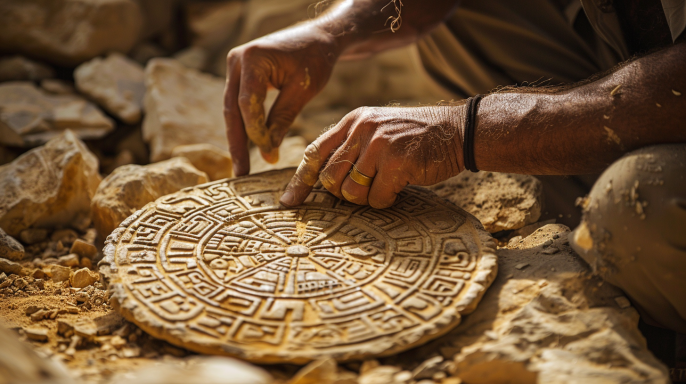Introduction
The Phaistos Disc, discovered in the Minoan palace of Phaistos on Crete, is a clay disc dating back to the second millennium BCE. Covered in a spiral of stamped symbols, its purpose and the meaning of its symbols remain undeciphered, making it one of archaeology’s most enigmatic artifacts.
Historical Background
The Minoan civilization, flourishing on Crete around 2000 to 1400 BCE, is known for its advanced architecture, art, and writing. The palace of Phaistos, one of the most important centers of Minoan culture, is where this mysterious disc was unearthed.
Discovery of the Phaistos Disc
The Phaistos Disc was discovered in 1908 by Italian archaeologist Luigi Pernier. It was found in the basement of the Minoan palace of Phaistos, buried in a layer of ash. The disc’s discovery sparked immediate interest and debate among scholars and archaeologists.
Description of the Disc
The Phaistos Disc is a circular clay artifact, approximately 15 centimeters in diameter and 1 centimeter thick. It is inscribed on both sides with a spiral of 241 stamped symbols, consisting of 45 distinct characters. The symbols include human figures, animals, plants, and abstract designs.
Theories about the Symbols
Various theories have been proposed regarding the nature of the symbols on the Phaistos Disc. Some scholars believe they represent a form of writing, possibly a syllabary or logographic system. Others suggest they might be pictograms or ideograms, conveying meaning through images rather than phonetic sounds.
Attempts at Decipherment
From its discovery, numerous attempts have been made to decipher the Phaistos Disc. Early efforts by archaeologists and linguists were largely speculative due to the lack of comparable texts. Modern approaches involve advanced technology, such as computer analysis and pattern recognition, but the symbols’ meaning remains elusive.
Proposed Functions of the Disc
The purpose of the Phaistos Disc is also a subject of speculation. Hypotheses range from it being a religious or ritualistic object, to a calendrical tool, to a form of administrative record. Some suggest it might have been used in ceremonies or as a talisman.
Cultural and Historical Context
Understanding the Phaistos Disc requires considering the broader context of Minoan society, which used various forms of symbolic representation. Similar artifacts from the period include Linear A tablets and other inscribed objects, which provide insights into the use of symbols in Minoan culture.
The Enigma of the Symbols
The unique and intricate symbols of the Phaistos Disc distinguish it from other known scripts of the time. The lack of similar artifacts or bilingual texts has made decipherment particularly challenging, adding to the disc’s mystique.
Significance in Archaeology
The Phaistos Disc holds significant archaeological importance as it challenges our understanding of ancient writing systems. It provides a glimpse into the complexity of Minoan civilization and its use of symbols for communication and record-keeping.
Controversies and Debates
The Phaistos Disc has been at the center of various controversies and scholarly debates. Some researchers question its authenticity, while others debate the validity of different decipherment theories. These discussions highlight the disc’s role in the broader field of ancient studies.
Modern Research and Discoveries
Recent research continues to explore the Phaistos Disc through interdisciplinary approaches, combining archaeology, linguistics, and digital technology. New findings and innovative methodologies offer hope that the disc’s secrets may eventually be unveiled.
The Phaistos Disc in Popular Culture
The enigmatic nature of the Phaistos Disc has captured the public imagination, inspiring numerous works of fiction, art, and media. It has become a symbol of mystery and the unknown, reflecting humanity’s fascination with ancient civilizations.
Comparison with Other Enigmatic Artifacts
The Phaistos Disc is often compared to other undeciphered scripts and mysterious artifacts, such as the Voynich Manuscript and the Rongorongo tablets of Easter Island. These comparisons highlight the universal appeal of archaeological puzzles and the quest for understanding.
Conclusion
The Phaistos Disc remains one of archaeology’s most captivating mysteries. Its undeciphered symbols and unknown purpose continue to intrigue researchers and enthusiasts alike. As technology and research methods advance, there is hope that this ancient artifact will one day reveal its secrets, offering deeper insights into the Minoan civilization.
FAQs
What is the Phaistos Disc?
The Phaistos Disc is a circular clay artifact from the Minoan civilization, inscribed with a spiral of stamped symbols, dating back to the second millennium BCE.
When and where was the Phaistos Disc discovered?
The Phaistos Disc was discovered in 1908 by Italian archaeologist Luigi Pernier at the palace of Phaistos on the island of Crete.
What do the symbols on the Phaistos Disc represent?
The symbols on the Phaistos Disc remain undeciphered, with theories suggesting they could be a form of writing, pictograms, or ideograms.
Has the Phaistos Disc been deciphered?
No, the Phaistos Disc has not been deciphered. Despite numerous attempts and modern technological approaches, its symbols’ meaning is still unknown.
Why is the Phaistos Disc significant?
The Phaistos Disc is significant because it represents a unique and enigmatic artifact from the Minoan civilization, challenging our understanding of ancient writing systems and cultural practices.

